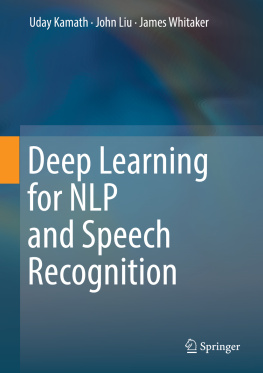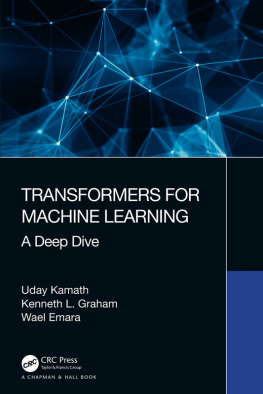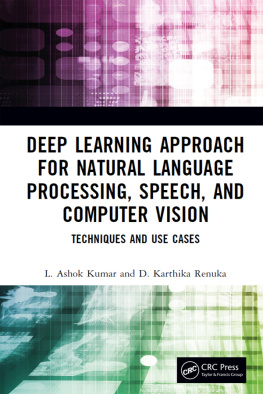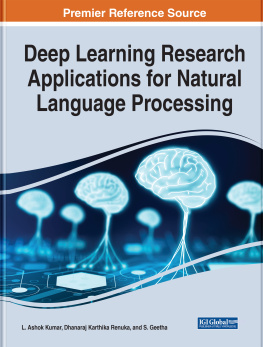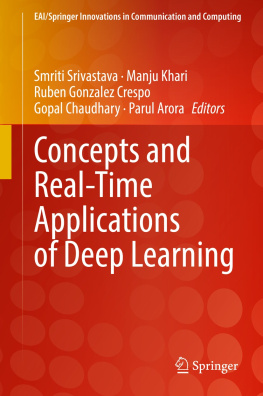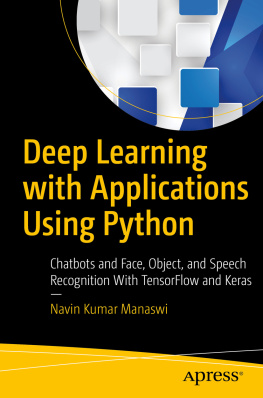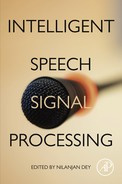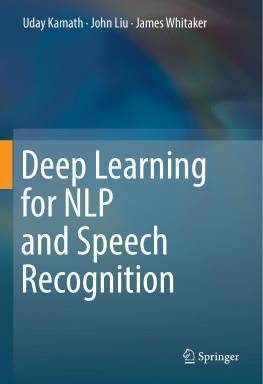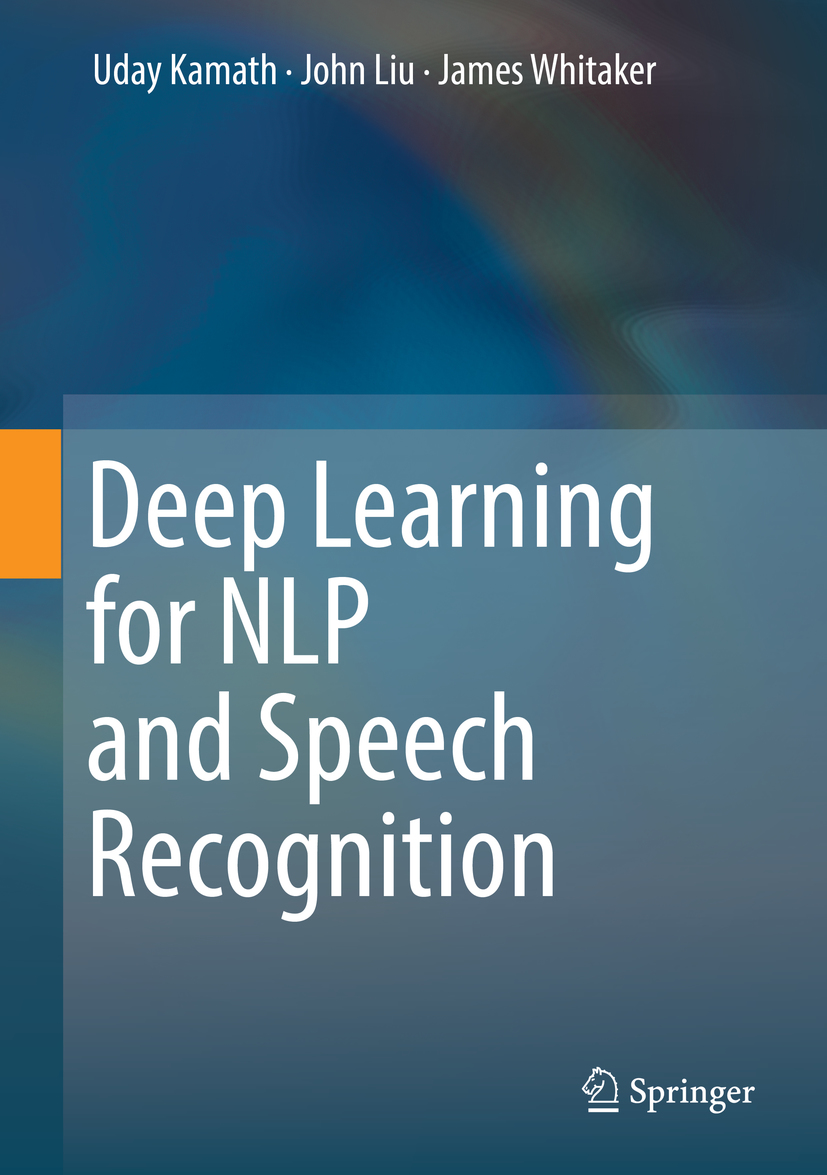Uday Kamath
Digital Reasoning Systems Inc., McLean, VA, USA
John Liu
Intelluron Corporation, Nashville, TN, USA
James Whitaker
Digital Reasoning Systems Inc., McLean, VA, USA
ISBN 978-3-030-14595-8 e-ISBN 978-3-030-14596-5
https://doi.org/10.1007/978-3-030-14596-5
Springer Nature Switzerland AG 2019
This work is subject to copyright. All rights are reserved by the Publisher, whether the whole or part of the material is concerned, specifically the rights of translation, reprinting, reuse of illustrations, recitation, broadcasting, reproduction on microfilms or in any other physical way, and transmission or information storage and retrieval, electronic adaptation, computer software, or by similar or dissimilar methodology now known or hereafter developed.
The use of general descriptive names, registered names, trademarks, service marks, etc. in this publication does not imply, even in the absence of a specific statement, that such names are exempt from the relevant protective laws and regulations and therefore free for general use.
The publisher, the authors, and the editors are safe to assume that the advice and information in this book are believed to be true and accurate at the date of publication. Neither the publisher nor the authors or the editors give a warranty, express or implied, with respect to the material contained herein or for any errors or omissions that may have been made. The publisher remains neutral with regard to jurisdictional claims in published maps and institutional affiliations.
This Springer imprint is published by the registered company Springer Nature Switzerland AG.
The registered company address is: Gewerbestrasse 11, 6330 Cham, Switzerland
Foreword
The publication of this book is a perfect timing. Existing books on deep learning either focus on theoretical aspects or are largely manuals for tools. But this book presents an unprecedented analysis and comparison of deep learning techniques for natural language and speech processing, closing the substantial gap between theory and practice. Each chapter discusses the theory underpinning the topics, and an exceptional collection of 13 case studies in different application areas is presented. They include classification via distributed representation, summarization, machine translation, sentiment analysis, transfer learning, multitask NLP, end-to-end speech, and question answering. Each case study includes the implementation and comparison of state-of-the-art techniques, and the accompanying website provides source code and data. This is extraordinarily valuable for practitioners, who can experiment firsthand with the methods and can deepen their understanding of the methods by applying them to real-world scenarios.
This book offers a comprehensive coverage of deep learning, from its foundations to advanced and recent topics, including word embedding, convolutional neural networks, recurrent neural networks, attention mechanisms, memory-augmented networks, multitask learning, domain adaptation, and reinforcement learning. The book is a great resource for practitioners and researchers both in industry and academia, and the discussed case studies and associated material can serve as inspiration for a variety of projects and hands-on assignments in a classroom setting.
Natural language and speech processing applications such as virtual assistants and smart speakers play an important and ever-growing role in our lives. At the same time, amid an increasing number of publications, it is becoming harder to identify the most promising approaches. As the Chief Analytics Officer at Digital Reasoning and with a PhD in Big Data Machine Learning, Uday has access to both the practical and research aspects of this rapidly growing field. Having authored Mastering Java Machine Learning , he is uniquely suited to break down both practical and cutting-edge approaches. This book combines both theoretical and practical aspects of machine learning in a rare blend. It consists of an introduction that makes it accessible to people starting in the field, an overview of state-of-the-art methods that should be interesting even to people working in research, and a selection of hands-on examples that ground the material in real-world applications and demonstrate its usefulness to industry practitioners.
A few years ago, I picked up a few text-books to study topics related to artificial intelligencesuch as natural language processing and computer vision. My memory of reading these text-books largely consisted of staring helplessly out of the window. Whenever I attempted to implement the described concepts and math, I wouldnt know where to start. This is fairly common in books written for academic purposes; they mockingly leave the actual implementation as an exercise to the reader. There are a few exceptional books that try to bridge this gap, written by people who know the importance of going beyond the math all the way to a working system. This book is one of those exceptionswith its discussions, case studies, code snippets, and comprehensive references, it delightfully bridges the gap between learning and doing.
I especially like the use of Python and open-source tools out there. Its an opinionated take on implementing machine learning systemsone might ask the following question: Why not X, where X could be Java, C++, or Matlab? However, I find solace in the fact that its the most popular opinion, which gives the readers an immense support structure as they implement their own ideas. In the modern Internet-connected world, joining a popular ecosystem is equivalent to having thousands of humans connecting together to help each otherfrom Stack Overflow posts solving an error message to GitHub repositories implementing high-quality systems. To give you perspective, Ive seen the other side, supporting a niche community of enthusiasts in machine learning using the programming language Lua for several years. It was a daily struggle to do new thingseven basic things such as making a bar chartprecisely because our community of people was a few orders of magnitude smaller than Pythons.
Overall, I hope the reader enjoys a modern, practical take on deep learning systems, leveraging open-source machine learning systems heavily, and being taught a lot of tricks of the trade by the incredibly talented authors, one of whom Ive known for years and have seen build robust speech recognition systems.
Carlotta Domeniconi Associate Professor at GMU
Sebastian Ruder Research Scientist at DeepMind
Soumith Chintala Research Engineer at Facebook AI Research (FAIR)
Fairfax, VA, USA London, UK New York, NY, USA
February 2019, February 2019, February 2019

